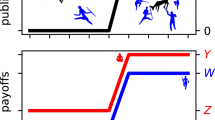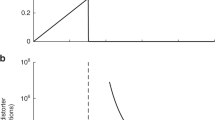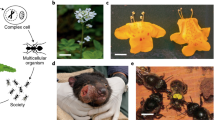Abstract
The evolution of altruism, a behaviour that benefits others at one's own fitness expense, poses a darwinian paradox. The paradox is resolved if many interactions are with related individuals so that the benefits of altruism are reaped by copies of the altruistic gene in other individuals1, a mechanism called kin selection2. However, recognition of altruists could provide an alternative route towards the evolution of altruism1,3,4,5. Arguably the simplest recognition system is a conspicuous, heritable tag, such as a green beard1,3. Despite the fact that such genes have been reported6,7,8, the ‘green beard effect’3 has often been dismissed because it is unlikely that a single gene can code for altruism and a recognizable tag1,3,9. Here we model the green beard effect and find that if recognition and altruism are always inherited together, the dynamics are highly unstable, leading to the loss of altruism. In contrast, if the effect is caused by loosely coupled separate genes, altruism is facilitated through beard chromodynamics in which many beard colours co-occur. This allows altruism to persist even in weakly structured populations and implies that the green beard effect, in the form of a fluid association of altruistic traits with a recognition tag, can be much more prevalent than hitherto assumed.
This is a preview of subscription content, access via your institution
Access options
Subscribe to this journal
Receive 51 print issues and online access
$199.00 per year
only $3.90 per issue
Buy this article
- Purchase on Springer Link
- Instant access to full article PDF
Prices may be subject to local taxes which are calculated during checkout




Similar content being viewed by others
References
Hamilton, W. D. The genetic evolution of social behaviour, II. J. Theor. Biol. 7, 17–52 (1964)
Maynard Smith, J. Group selection and kin selection. Nature 201, 1145–1147 (1964)
Dawkins, R. The Selfish Gene (Oxford Univ. Press, Oxford, 1976)
Dawkins, R. The Extended Phenotype (Oxford Univ. Press, Oxford, 1982)
Riolo, R., Cohen, M. D. & Axelrod, R. Evolution of cooperation without reciprocity. Nature 414, 441–443 (2001)
Queller, D. C., Ponte, E., Bozzaro, S. & Strassmann, J. E. Single-gene greenbeard effects in the social amoeba Dictyostelium discoideum. Science 299, 105–106 (2003)
Keller, L. & Ross, K. G. Selfish genes: a green beard in the red fire ant. Nature 394, 573–575 (1998)
Summers, K. & Crespi, B. Cadherins in maternal-foetal interactions: red queen with a green beard? Proc. R. Soc. Lond. B 272, 643–649 (2005)
Blaustein, A. R. Kin recognition mechanisms—phenotypic matching or recognition alleles. Am. Nat. 121, 749–754 (1983)
Trivers, R. The evolution of reciprocal altruism. Q. Rev. Biol. 46, 35–57 (1971)
Van Baalen, M. & Rand, D. The unit of selection in viscous populations and the evolution of altruism. J. Theor. Biol. 193, 631–648 (1998)
Nowak, M. A. & May, R. M. Evolutionary games and spatial chaos. Nature 355, 826–829 (1992)
West, S. A., Pen, I. & Griffin, A. S. Conflict and cooperation—Cooperation and competition between relatives. Science 296, 72–75 (2000)
Hamilton, W. D. in Kin Recognition in Animals (eds Fletcher, D. J. C. & Michener, C. D.) 417–438 (Wiley, Chichester, 1987)
Haig, D. Gestational drive and the green-bearded placenta. Proc. Natl Acad. Sci. USA 93, 6547–6551 (1996)
Van Baalen, M. & Jansen, V. A. A. Common language or Tower of Babel? On the evolutionary dynamics of signals and their meanings. Proc. R. Soc. Lond. B 270, 69–76 (2003)
Axelrod, R., Hammond, R. A. & Grafen, A. Altruism via kin-selection strategies that rely on arbitrary tags with which they coevolve. Evolution 58, 1833–1838 (2004)
Haig, D. in Behavioural Ecology 4th edn (eds Krebs, J. R. & Davies, N. B.) 284–306 (Cambridge Univ. Press, Cambridge, 1997)
Axelrod, R. The Evolution of Cooperation (Basic Books, New York, 1984)
Hofbauer, J. & Sigmund, K. Evolutionary Games and Population Dynamics (Cambridge Univ. Press, Cambridge, 1998)
Acknowledgements
We thank P. Credland for his encouragement and comments on the manuscript. Author Contributions Both authors contributed equally to this paper. V.A.A.J. formulated and analysed the mathematical model; M.v.B. formulated and analysed the simulation model.
Author information
Authors and Affiliations
Corresponding author
Ethics declarations
Competing interests
Reprints and permissions information is available at npg.nature.com/reprintsandpermissions. The authors declare no competing financial interests.
Supplementary information
Supplementary Methods
This file contains additional details on the methods used in this study. (PDF 164 kb)
Rights and permissions
About this article
Cite this article
Jansen, V., van Baalen, M. Altruism through beard chromodynamics. Nature 440, 663–666 (2006). https://doi.org/10.1038/nature04387
Received:
Accepted:
Issue Date:
DOI: https://doi.org/10.1038/nature04387
This article is cited by
-
Multiple social encounters can eliminate Crozier’s paradox and stabilise genetic kin recognition
Nature Communications (2022)
-
Temporal assortment of cooperators in the spatial prisoner’s dilemma
Communications Biology (2021)
-
Ethnic Markers and How to Find Them
Human Nature (2021)
-
Retrotransposon gag-like 1 (RTL1) and the molecular evolution of self-targeting imprinted microRNAs
Biology Direct (2019)
-
The rise and fall of cooperation through reputation and group polarization
Nature Communications (2019)
Comments
By submitting a comment you agree to abide by our Terms and Community Guidelines. If you find something abusive or that does not comply with our terms or guidelines please flag it as inappropriate.



